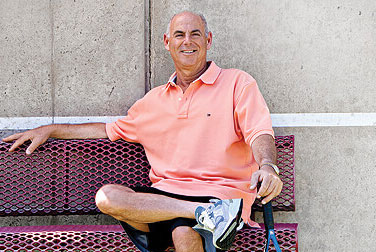“For a bad situation, this (surgery) couldn’t have possibly gone better for me. If something like this happens to you, you should be in Dr. Shiroff ’s hands.”

The car crash came without warning. Stanley Sackowitz, of Hamilton, felt lucky to be alive after the initial impact. Then, the pain set in — mind-numbing pain resulting from 11 broken ribs that left him gasping for breath.
“Each time I would try to breathe, the pain was overwhelming. I couldn’t get enough air,” recalled Mr. Sackowitz, who also suffered a collapsed lung and fractured hip.
“Mr. Sackowitz’s injuries required the expertise of the Robert Wood Johnson University Hospital (RWJUH) health system’s Level I Trauma Center Shown: Stanley Sackowitz is back to playing tennis again thanks to the trauma team at Robert Wood Johnson University Hospital who used an innovative procedure to repair his 11 broken ribs. team. Our team met his immediate needs and we collaborated with trauma surgeons in New Brunswick to coordinate an emergency transport,” says Eileen Singer, DO, Chair of the Emergency Medicine Department at RWJUH-Hamilton, recently recognized by HealthGrades with the Emergency Medical Excellence Award. One of only three Level I Trauma Centers in the state, RWJUH’s trauma surgeons are specially trained to assess and treat severe injuries like the ones Mr. Sackowitz suffered. Trauma patients receive care from a highly-skilled team that includes trauma surgeons, emergency physicians, nurses, radiology technicians, blood bank and case management staff and many other disciplines who work together seamlessly to return individuals to health.
According to Adam Shiroff, MD, FACS, Assistant Professor of Surgery at UMDNJ-Robert Wood Johnson Medical School (RWJMS) and Associate TRAUMA CARE Returning to a Healthy Serve Director of the Trauma Program at RWJMS and RWJUH, Mr. Sackowitz suffered a rib flail — the broken ribs were detached from the chest wall, hindering his ability to breathe and causing him severe pain with any movement.
“His breathing was functioning at about 15 percent of what it should have been,” Dr. Shiroff explained. Patients who suffer rib flail can have serious complications, such as pneumonia, Dr. Shiroff notes. They cannot move easily in bed and they lack the ability to move air in and out of their lungs freely, resulting in fluid build-up and infections. Given the severity of Mr. Sackowitz’ injury and the risk of complications, Dr. Shiroff and the trauma team performed rib fixation surgery, an innovative procedure that is available at only a small number of trauma centers in our region.
Rib fixation involves exposing the fractured ribs, elevating them manually and aligning them to the normal slope of the patient’s chest. Titanium plates are inserted, molded around the fractured ribs and screwed in place.
“Patients can experience immediate relief from their pain,” Dr. Shiroff said. “Not all patients are eligible to receive this surgery, but those who can respond very well.”
“Almost immediately, I had no pain to speak of,” Mr. Sackowitz added.
A former collegiate soccer player and youth coach, the 54-year-old father of three was extremely active before the accident, regularly playing tennis and golf. The ordeal has been frustrating and he was concerned about the impact it had on his children.
“They were taking it pretty hard,” Mr. Sackowitz said. “We are a close family and do everything together. I had a big incentive to get well.” Mr. Sackowitz has completed physical rehabilitation and is working again.
“For a bad situation, this (surgery) couldn’t have possibly gone better for me. If something like this happens to you, you should be in Dr. Shiroff ’s hands.”